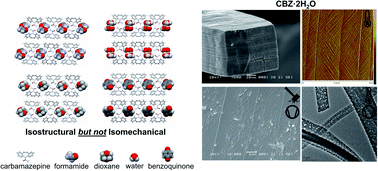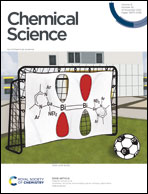Understanding stress-induced disorder and breakage in organic crystals: beyond crystal structure anisotropy†
Abstract
Crystal engineering has advanced the strategies for design and synthesis of organic solids with the main focus being on customising the properties of the materials. Research in this area has a significant impact on large-scale manufacturing, as industrial processes may lead to the deterioration of such properties due to stress-induced transformations and breakage. In this work, we investigate the mechanical properties of structurally related labile multicomponent solids of carbamazepine (CBZ), namely the dihydrate (CBZ·2H2O), a cocrystal of CBZ with 1,4-benzoquinone (2CBZ·BZQ) and the solvates with formamide and 1,4-dioxane (CBZ·FORM and 2CBZ·DIOX, respectively). The effect of factors that are external (e.g. impact stressing) and/or internal (e.g. phase transformations and thermal motion) to the crystals are evaluated. In comparison to the other CBZ multicomponent crystal forms, CBZ·2H2O crystals tolerate less stress and are more susceptible to breakage. It is shown that this poor resistance to fracture may be a consequence of the packing of CBZ molecules and the orientation of the principal molecular axes in the structure relative to the cleavage plane. It is concluded, however, that the CBZ lattice alone is not accountable for the formation of cracks in the crystals of CBZ·2H2O. The strength and the temperature-dependence of electrostatic interactions, such as hydrogen bonds between CBZ and coformer, appear to influence the levels of stress to which the crystals are subjected that lead to fracture. Our findings show that the appropriate selection of coformer in multicomponent crystal forms, targetting superior mechanical properties, needs to account for the intrinsic stress generated by molecular vibrations and not solely by crystal anisotropy. Structural defects within the crystal lattice, although highly influenced by the crystallisation conditions and which are especially difficult to control in organic solids, may also affect breakage.



 Please wait while we load your content...
Please wait while we load your content...